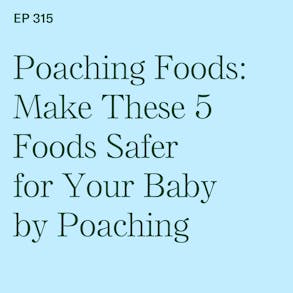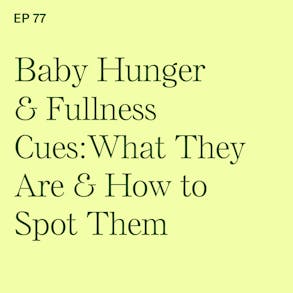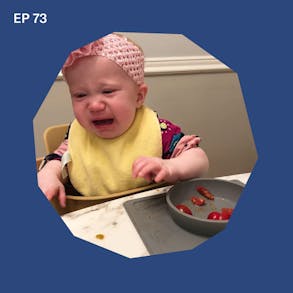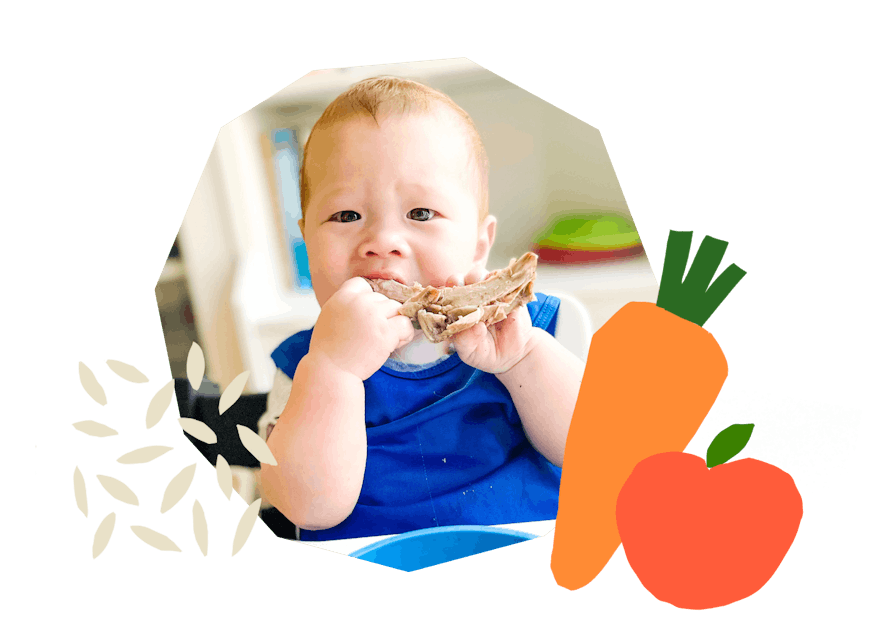Poaching Foods: Make These 5 Foods Safer for Your Baby by Poaching
In this episode we're talking about:
- How to poach foods and why it works particularly well for not-yet-ripe fruits
- Which foods poach better than others and how long to poach foods for
- How to cut high water content pieces of food prior to poaching

LISTEN TO THIS EPISODE
Episode Description
Poaching is a moist-heat cooking method that can be your secret weapon in the kitchen for making foods safer for your baby to self-feed. In this episode I’m sharing 5 of my favorite foods that I regularly poach as part of basic baby-led weaning food preparation.
Links from this Episode
- Baby-Led Weaning with Katie Ferraro program with the 100 First Foods™ Daily Meal Plan, join here: https://babyledweaning.co/program
- Baby-Led Weaning for Beginners free online workshop with 100 First Foods™ list to all attendees, register here: https://babyledweaning.co/baby-led-weaning-for-beginners

Latest Episodes






Katie Ferraro (56s):
And so I didn't realize that most people only know about Poaching with regards to fish and Poaching fish is a way, a really easy way for you to make fish a potentially allergenic food, totally safe for your baby to eat, but there are so many other Foods that you can also poach that helps make them that nice soft consistency that is then safe to offer to your baby. For baby led weaning Hey there, I'm Katie Ferraro, registered dietitian, college nutrition professor and mom of seven specializing in baby led weaning here on the Baby Led Weaning Made Easy podcast I help you strip out all of the noise and nonsense about feeding, leaving you with the confidence and knowledge you need to give your baby a safe start to solid Foods using baby led weaning.
Katie Ferraro (1m 45s):
All right, let's say you've got a copy of my hundred first Foods list and you've picked out the five new Foods that your baby is going to eat this week. We choose them from one of each of the five categories, so a new fruit on Monday, a new vegetable on Tuesday, a starchy food on Wednesday, a protein food on Thursday, and an allergenic food on Friday. That's my five step feeding framework. And you're like, yes, I did it. This is my, I'm gonna meal prep, I'm gonna get ready. It's time to do the new fruit of the day. Let's say it's pear and oh my gosh, the pear is too hard to feed the baby, right? We don't offer any raw, crunchy or crispy Foods like hard pears or apples or carrots or bell peppers. What do you do to make it Safer? Well, I am a huge fan of Poaching.
Katie Ferraro (2m 26s):
It's a very simple kitchen technique that can help make a lot of Foods immediately Safer for your baby to eat for baby led weaning and In. this episode I wanna cover five Foods that are easy to make Safer for baby led weaning by Poaching. Now I like to start each of these mini baby led weaning training episodes with a BLW tip of the day. And today's tip, no raw, crunchy, hard or crispy Foods for your baby. I don't even care if your baby has a tooth, okay? I don't care if your baby has a lot of teeth, hard, rock, crunchy, crispy Foods are choking hazards for Babies and it is of the utmost importance that we're offering softer pieces of food, especially for those early eaters.
Katie Ferraro (3m 8s):
But hang tight cuz in this episode I'm gonna tell you how five of the Foods that I picked off of the 100 1st Foods list can easily be made Safer by Poaching So. What exactly is Poaching? I'm not talking about illegal killing of endangered species or animals. This is a cooking technique. And I remember when I had to take an introduction to food preparation as part of my undergraduate nutrition training to become a dietitian. We had a test on all of these different like moist versus dry cooking methods and I remember being like, I haven't heard of like any of these. And then when I found out what Poaching is, it's a moist heat cooking method. So meaning there's, there's liquids involved where you submerge food in some sort of liquid and then you heat it at a low temperature.
Katie Ferraro (3m 53s):
So it's kind of like a gentle way of cooking like just below a boil. And then what it ends up doing is kind of releasing some of the flavors back into the cooking fluid, which in baby led weaning we're definitely going to use as we offer it to the baby. Now what's the point of Poaching? Well, it's to make food so that we're maybe on ripe or not quite yet ready to feed to your baby softer so that they're for it tender or they pass what we call the squish test. Meaning if you push them between your forefinger and your thumb, there's a little bit of give there, right? We don't want anything that snaps or breaks or crunches or is crispy because that could be a choking hazard for your baby. Now what sort of Foods can you poach?
Katie Ferraro (4m 34s):
Quick story. I was just visiting my friend Madeline, her baby Lachlan turned seven months of age and he'd been starting solid Foods about about two weeks. So, we went there, I did five new Foods with him over the course of a weekend. I was visiting there in Boston. So I took my girls for a long weekend and I'm really good friends with Mad's mom, who is the baby's grandmother and So. We were like all talking about the different Foods and I just said something about Poaching and Mad, who is a very smart person with like a million degrees was like, I'm sorry for the lay person who maybe doesn't cook baby food for a living. What exactly are you talking about when you're talking about Poaching? And I was telling my team, I'm like, dude, I didn't even think about it. Like people don't even know what Poaching is. Like I didn't know what Poaching was at one time.
Katie Ferraro (5m 15s):
And then Lauren on our team was like, Katie, like most people don't think about Poaching fruit. Like you think about Poaching fish maybe as a food cooking method. And I guess it depends upon like your level of you know, kitchen literacy, but you can poach all sorts of Foods to make them softer. And so a lot of times when we think about like vegetables, like you know you can't serve your baby raw broccoli, right? So, what are you gonna do with it? You're gonna cook it in some boiling water and make it softer so the baby can eat. But you can do the same thing for fruits. So in no particular order, here are five Foods that I poach on the reg for baby led weaning. The first one being apples. Okay? Apples and raw apples in particular raw apples are one of the biggest choking hazard Foods for Babies. If you look at non-fatal emergency department admission data in for pediatric choking apples are like always cited up there as a food that kids and ostensibly Babies can choke on.
Katie Ferraro (6m 4s):
Now that data doesn't always differentiate between like which of the age group was six to 12 months, which was above 12 months. But like we know raw apples are a choking hazard, but apples are an awesome food for your baby, right? Like all fruits and vegetables, they contain vitamin C and that vitamin C is important for helping your baby absorb iron from the other Foods that they're learning how to eat in the diet. Hey, we're gonna take a quick break, but I'll be right back.
Katie Ferraro (7m 30s):
So while we don't do raw, crunchy or crispy pieces of apple, you can make apple safe for Babies by peeling the apple, by slicing the apple, by coring the apple, and then cutting it into strips about the size of your adult pinky finger and Poaching it in a little bit of water. Okay? You poach it until it's for tundra where it passes that squish test. And also keep in mind that most fruits and vegetables are high water content food, so they will shrink a little bit. So I actually kind of cut the raw piece a little bit larger than I want the finished cook piece to be. And then I'll sprinkle cinnamon or nutmeg on those apple slices, put 'em in a bowl that the baby can then use their whole hand or their palmer grass to rake or scoop those apple slices up and into their mouth and safely eat apples.
Katie Ferraro (8m 11s):
So I love Poaching apples. Now kind of along the same lines, I poach a lot of pears. I love buying pears, but they're never ripe. And then they're kinda like avocados where it's like unripe, unripe, unripe and then boom, too ripe. Now it's black, you don't wanna eat it if the pear is perfectly ripe and nice and soft and squishy. There are situations where you can feed a raw pair to a baby, but like 99 times out of a hundred is not gonna be that day when you wanna do pear and the pear is that ready for you as you are for the pair. So you can poach the pair. Same thing as with the apples. You peel it, you slice it, you core it, cut it into strips about the size of your adult pinky finger, slightly larger, poach it for a few minutes until it's nice and soft.
Katie Ferraro (8m 51s):
And pears are a really easy one to make soft for baby led weaning. Another food I poach a lot is mangoes. I feel like I talk about this all the time on the podcast, but I love mango, right? We love Foods that are bright orange and yellow. They're really good sources of vitamin A, which is a fat soluble vitamin, helps your baby get the nutrition out of the other fat containing Foods that you're offering. But mangoes a lot of times are too hard for Babies to eat. And so I know personally I hate cutting and slicing mangoes. It's like one of my least favorite things to do. I actually get, this might be T m I, but like a topical rash. So I get some atopic dermatitis whenever I have mango touch the outside of my mouth. I learned this when I was a Peace Corps volunteer in Nepal and like there was not a lot of variety of fruit but like the mango season was so short and you would just like eat the heck out of any mangoes you could get your hands on.
Katie Ferraro (9m 36s):
It would make my lifts BLW up and it would get a rash all over my face. Totally harmless, but like I loved mango that much and I was like, I don't care. So I don't really like mango like touching my face and I don't like cutting it and peeling it. It's a lot of work. So one of the few convenience Foods that I will allow myself as a luxury are is the precut mango from Costco. My kids love it but it tends to be very expensive. So, we eat it in moderation, but whenever I do it for Babies it's like rock hard and never safe enough for them to eat. So put it in a little bit of water, poach it, get it. The mango can take a like a lot longer. Like I've done some mango for up to 20 minutes before it got soft. So some of these you like in two minutes, they're ready. you know, you just gotta get your fork in there and just keep testing it until it's the right texture for your baby.
Katie Ferraro (10m 16s):
So mango is another good one. This list might be more than five cuz I wrote down five. But I keep thinking of other Foods that I poach. I poach a lot of fruit because like you guys cook vegetables to make them soft. Do the same thing for fruits if you want to. Okay? We only wanna be offering those soft strips of food. I did melon the other day, we were working with Baby Alma and the cantaloupe wasn't ready. Like one of the cants I had was like so rotten. It smelled like, like it was so fermented, it smelled like alcohol. I'm like I can't feed this to a baby. And then the other one was so un ripe that I had to poach it. So you can do it for melon, you literally can do it for everything and then save that little juice kind of will mash it up. If you're gonna puree it and do off of preloaded spoon, you can use the juice that you were cooking in for a little extra flavor, right? Cuz fruits are natural sources of sugar and it's fine for Babies to have fruit sugar.
Katie Ferraro (10m 58s):
We just don't wanna add any sugars. Another food that I poach quite frequently, I just did this with baby Lachlan or parsnips. Well really any vegetable that you roast, like I never give myself enough time and so they never get soft enough in the oven. So like roast it to bring out the flavor, I'm like, oh crap, the baby's gonna be here in a minute to go throw it in a little bit of water to finish it off. So I was roasting parsnips for baby Lachlan and he was like getting to the point where I'm like, shoot, if I don't give this baby food really soon, we're gonna pass the window where he is gonna want to eat and he's gonna take his nap, blah blah blah. So I just poached a little bit of the half-cooked parsnips and it's kind of a good way to like finish off the softness. It just gets him softer a lot faster. And to be honest, Babies really don't care if you end up even boiling their vegetables.
Katie Ferraro (11m 40s):
Hey, we're gonna take a quick break, but I'll be right back.
Katie Ferraro (12m 49s):
All right, last one I wanna talk about is Fish because according to Lauren, lots of people poach fish. I think it's a texture thing, it's not my favorite, but it does make a really cool, nice soft final texture for offering your baby fish. And fish is one of the big nine allergenic Foods, right? Those are the nine Foods that account for about 90% of food allergy. So fish as a allergenic food category is separate from shellfish and a lot of parents are like cool, but like I don't like to cook fish. Poaching fish is so easy. You just basically take a pan large enough to put the fish in. You can do low sodium broth, you can put some wine in there. I cook, I cook with wine all the time for Babies it, it burns off. If you don't feel comfortable doing that, you can just use vinegar in place or you can use no salt broth, you can do water, you put the fish in there, you cook it until it's just cooked through.
Katie Ferraro (13m 33s):
So with, for something like salmon for example, it takes about six minutes. Okay? And you get it that nice super soft, flaky consistency. Obviously you're always gonna spot check for bones with fish. Kind of run my fingers through the cooked flesh of the fish, remove any of the skin. You can add extra oil on top of there if you want. But I love a fatty fish like salmon. And so Poaching is a way that you can make fish safe for your baby to eat as well. So there you have it, five plus Foods that you can poach to make it Safer for your baby to eat. These Foods. All the Foods that I chose and talked about today are from my hundred first Foods list. If you guys wanna grab a copy of that list, I teach a free one hour online video workshop each week called Baby led weaning for beginners.
Katie Ferraro (14m 15s):
And I show you a lot about safe Food preparation method and how to make the different Foods on the 100 1st Foods list safe. I walk you through the first 10 days of baby led weaning. We talk about how to get over your fears of gagging and choking and how to do allergenic Foods so that you can help reduce your baby's risk of food allergies. That's all on the baby-led weaning for beginners workshop. And everybody on that workshop gets a copy of my 100 1st Foods list, cuz I never want you to run out of ideas of Foods. Your baby can safely eat. You can sign up for this week's workshop times and grab your copy of the hundred first Foods list at baby led weaning dot co. Again, that's baby led weaning dot co. Get signed up for this week's workshop. Workshop times. I just redid the whole workshop. I'm so excited about it. It sometimes goes over a little bit over an hour because we do a long q and a, but I make a point to answer every single question that you ask on those workshops.
Katie Ferraro (15m 2s):
So if you have any burning baby led weaning questions, sign up for the baby-led weaning for beginners workshop, Get your copy of the 100 1st foods through list. It's all linked up for you at baby led weaning dot co. And a special thanks to our partners at AirWave Media. If you guys like podcasts that feature food and fun and science in using your brain, maybe they even have some episodes about Poaching fish, who knows? Check out AirWave Media. We're online at BLW podcast.com. A link to some of the resources from this episode in the show notes, which you can find at blwpodcast.com/315. Thanks for listening. Go poach your baby some Foods. you guys.

The Program Baby-Led Weaning with Katie Ferraro
A step-by-step digital program for starting solid foods safely and navigating the original 100 FIRST FOODS™ meal plan with baby-led weaning.
 EXPERT-LED, PROVEN APPROACH TO EATING REAL FOOD
EXPERT-LED, PROVEN APPROACH TO EATING REAL FOOD CONCISE VIDEO TRAININGS TO MASTER BABY-LED WEANING
CONCISE VIDEO TRAININGS TO MASTER BABY-LED WEANING 100 FIRST FOODS DAILY MEAL PLAN WITH FOOD PREP VIDEOS
100 FIRST FOODS DAILY MEAL PLAN WITH FOOD PREP VIDEOS
Baby-Led Weaning for Beginners Free Workshop
Is your baby ready to start solid foods, but you’re not sure where to start? Get ready to give your baby a solid foundation to a lifetime of loving real food…even if you’re feeling overwhelmed or confused about this next stage of infant feeding.
Get baby-led weaning recipes and tips delivered to your email inbox.

